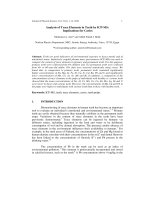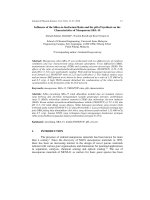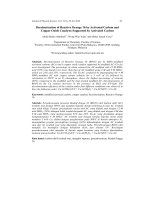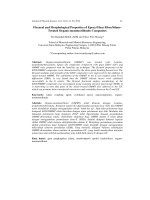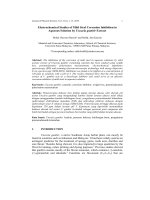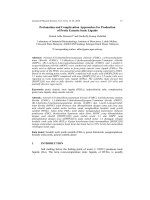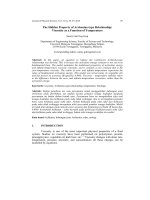Báo cáo vật lý: "Removal of Hexacyanoferrate(II) Using Zn-Al-OAc Hydrotalcite as an Anion Exchanger" pdf
Bạn đang xem bản rút gọn của tài liệu. Xem và tải ngay bản đầy đủ của tài liệu tại đây (225.69 KB, 12 trang )
Journal of Physical Science, Vol. 20(2), 73–84, 2009 73
Removal of Hexacyanoferrate(II) Using Zn-Al-OAc
Hydrotalcite as an Anion Exchanger
Roto Roto
*
, Fitriana Nindiyasari and Iqmal Tahir
Department of Chemistry,
Faculty of Mathematics and Natural Sciences,
Gadjah Mada University, Sekip Utara, Yogyakarta 55281, Indonesia
*
Corresponding author:
Abstract: Cyanide is a highly toxic anion and ingestion exposure can be fatal. Cyanide
can be removed from water systems using Zn-Al-OAc hydrotalcite (OAc
-
=acetate) as an
ion exchanger. A synthesis of Zn-Al-OAc hydrotalcite has been performed and it was used
as an anion exchanger to reduce the concentration of cyanide in the form of [Fe(CN)
6
]
4-
.
Zn-Al-OAc hydrotalcite was prepared using a stoichiometric method followed by
hydrothermal treatment. The chemical composition of Zn-Al-OAc hydrotalcite was found
to be Zn
0.73
Al
0.27
(OH)
2
(OAc)
0.27
.0.95H
2
O. The anion exchange reaction of OAc
-
by
[Fe(CN)
6
]
4-
was fit to yield a second order reaction rate constant of k = 0.215 M
-1
s
-1
with
R
2
=0.996. The anion exchange capacity (AEC) was found to be 219 meq [Fe(CN)
6
]
4-
/100
g hydrotalcite. It was found that Zn-Al-Fe(CN)
6
hydrotalcite could not be regenerated by
OAc
-
.
Keywords: hydrotalcite, acetate, anion exchange capacity, hexacyanoferrate(II),
regeneration
Abstrak: Sianida merupakan anion yang sangat toksik, dan jika tertelan boleh membawa
maut. Sianida boleh dikeluarkan dari sistem air menggunakan Zn-Al-OAc hidrotalsit
(OAc
-
=acetate) sebagai penukar ion. Sintesis terhadap Zn-Al-OAc hidrotalsit telah
dijalankan dan telah digunakan sebagai penukar anion untuk mengurangkan penumpuan
sianida dalam bentuk [Fe(CN)
6
]
4-
. Zn-Al-OAc hidrotalsit telah disediakan menggunakan
kaedah stoichiometric diikuti dengan rawatan hidrotermal. Komposisi kimia Zn-Al-OAc
hidrotalsit telah ditemukan menjadi Zn
0.73
Al
0.27
(OH)
2
(OAc)
0.27
.0.95H
2
O. Tindakbalas
penukaran anion daripada OAc
-
dengan [Fe(CN)
6
]
4-
telah menghasilkan kadar tetap laju
reaksi tahap kedua, k = 0.215 M
-1
s
-1
dengan R
2
=0.996. Kapasiti penukaran anion (AEC)
telah ditemukan menjadi 219 meq [Fe(CN)
6
]
4-
/100 g hidrotalsit. Zn-Al-Fe(CN)
6
hidrotalsit telah ditemukan bahawa ia tidak boleh digunakan semula oleh OAc
-
.
Kata kunci: hidrotalsit, asetrat, kapasiti penukaran anion, heksasianoferrat (II),
penjanaan semula.
Removal of Hexacyanoferrate(II) 74
1. INTRODUCTION
Cyanide is widely used in industry, especially for cleaning metals and
electroplating. It is one of the main effluent pollutants produced by gas works and
coke ovens. It is also used in certain mineral-processing operations. Silver and
gold mining operations, chemical processing facilities, steel and iron industries,
metallurgical industries, metal plating and finishing facilities and petroleum
refineries are the largest sources for cyanide release into the water or air. The
maximum legal limit of cyanide in fresh water is 0.08 mg/L.
1
Cyanide has high acute (short-term) toxicity to aquatic life, birds, and
animals. Cyanide also has high chronic (long-term) toxicity to aquatic life, but it
is not expected to bio-accumulate. Cyanide compounds may exist in the
atmosphere as gases or small particles, where they are dispersed by air currents
and may settle into the soil or water. Most cyanide compounds are water-soluble
and can contaminate ground water. Both natural and human processes are
responsible for cyanide in the environment. In the air, it is mainly found as
gaseous hydrogen cyanide, although a small amount is present in fine dust
particles. Most of the cyanide dissolved in surface water will form hydrogen
cyanide and evaporate. It takes years for cyanide to break down from the air.
Removal of CN
−
by adsorption is commonly performed using adsorbents
such as active carbon, impregnated carbon and bentonite-loaded fabric strips.
2
However, activated carbon is expensive and impractical to prepare. Cyanide is
also slowly degraded to carbon dioxide and nitrous oxide by hydrogen peroxide.
3
Treatment of a 100 mg/L solution of cyanide with 3000 mg/L of hydrogen
peroxide will only degrade 80% after 4 h and 90% after 24 h. In the presence of
UV irradiation from a 25-W mercury lamp and 1200 mg/L of hydrogen peroxide,
complete degradation of a 100 mg/L solution was observed in 40 min.
3
Hydrotalcite-like compounds, also known as layered double hydroxides
(LDH), or anionic clays, are a class of lamellar compounds that consist of
positively charged brucite-like host layers that are charge balanced by hydrated,
exchangeable anions in the interlayer regions. The brucite-like layers are charged
due to isomorphous substitution of divalent metal ions with trivalent ones. The
chemical compositions of LDHs are expressed by the general formula [M(II)
1-
x
M(III)
x
(OH)
2
][A
n-
x/n
.mH
2
O], where M(II) and M(III) represent divalent and
trivalent metal ions within the brucite-like layers, and A
n-
is an interlayer anion.
4,5
Such A
n–
anions may be polymers, organic dyes, surfactants or organic acids
including anionic pesticides.
6,7
The ratio x, which is defined as
M(III)/M(II)+M(III), ranges from 0.20 to 0.33. The best known of these materials
is hydrotalcite, Mg
6
Al
2
(OH)
16
(CO
3
).4H
2
O, whose structure is derived from
brucite, Mg(OH)
2
and is similar to cadmium iodide in structure. It consists of
Journal of Physical Science, Vol. 20(2), 73–84, 2009 75
hexagonally close-packed layers of anions with 100% of the octahedral sites
occupied by magnesium cations in every two hydroxyl layers. This is termed a
layered structure, as it is composed of repeating OH-Mg-OH OH-Mg-OH OH-
Mg-OH units, where the OH OH interaction is mainly of the Van der Waals
type. If cations with a higher charge but similar radius are isomorphically
substituted for Mg
2+
, the brucite-like layers become positively charged. This
charge excess is balanced by anions in the non-metallic layers, along with water
molecules. In the case of natural hydrotalcite, two of every eight Mg
2+
cations are
substituted by trivalent ions (e.g. Al
3+
, Fe
3+
).
8
Hydrotalcite-like compounds are widely investigated for their potential
applications in research and industrial processes as catalysts, catalyst precursors,
anion exchangers, medicines, nanometer-sized composite materials, and electrode
modifying materials. The utility of these compounds, including the acetate-
containing ones, is due to their inorganic and organic anion exchange
capabilities.
9-20
Of special note are the layered organic/inorganic hybrid materials,
which can easily be synthesized by an ion-exchange reaction that substitutes
interlayer ions with organic guest anions.
21
Hydrotalcite-like compounds undergo ion-exchange reactions with
unhydrated anions. The ion-exchange equilibrium constants for hydrotalcite
appear in the order OH
-
> F
-
> Cl
-
> Br
-
> NO
3
-
> I
-
for monovalent anions, and
CO
3
2-
> C
10
H
4
N
2
O
8
S
2-
> SO
4
2-
for divalent anions
22
. For oxoanions, the order is
HPO
4
2-
> HAsO
4
2-
> CrO
4
2-
> SO
4
2-
> MoO
4
2-
. Hydrotalcites can be used as anion
exchangers. By utilising their characteristic ion selectivities, hydrotalcites are
expected to find applications in the removal of anion pollutants from liquids,
which are difficult to handle and process because of the difficulty in precipitation.
Treatment with an anion exchanger is a common process, yet it is usually more
expensive.
High anion exchange capacity and the ability to be regenerated are
important factors governing the utility of hydrotalcite as an anion exchanger. In
our previous publications, we have reported that Zn-Al-NO
3
hydrotalcite can be
used in the removal of hexacyanoferrate(II) as well as dichromate.
23,24
Likewise,
Zn-Al-SO
4
hydrotalcite is also a good anion exchanger for absorption of aqueous
hexacyanoferrate(II).
25
In this study, we report on the use of Zn-Al-OAc
hydrotalcite as ion exchanger to remove [Fe(CN)
6
]
4-
from solutions. Zn-Al-OAc
hydrotalcite is easy to prepare and is not toxic. Hexacyanoferrate(II), a common
cyanide complex in water, is expected to exchange the acetate ion in the
interlayer space of Zn-Al-OAc hydrotalcite. This study focuses on characterising
the anion exchange capacity, kinetics, and regeneration of this reaction.
Removal of Hexacyanoferrate(II) 76
2. EXPERIMENTAL
2.1 Synthesis and Characterisation of Hydrotalcite Zn-Al-NO
3
A 100 mL solution of 0.30 M Zn(NO
3
)
2
and a 100 mL solution of
0.10 mL Al(NO
3
)
3
were prepared. Next, the aqueous solution was titrated with a
100 mL of 0.50 M NaOH under vigorous stirring. The mixture was purged with
nitrogen gas to reduce the incorporation of carbonate and the pH of the solution
was maintained at 8 using NaOH. After 2 h of stirring, hydrothermal treatment at
100ºC was performed. The product was centrifuged, filtrated and washed. The
product was then dried at 100°C for 24 h, and crushed. This product is hereto
referred as Zn-Al-NO
3
hydrotalcite.
26
Powder X-ray diffraction (PXRD) patterns of the samples were acquired
with a Shimadzu Diffractometer XRD-6000. Fourier transform Infared
Spectroscopy (FTIR) spectra were recorded using a Shimadzu FT-IR-820 IPC.
The Zn/Al ratio and AEC was determined using a Perkin Elmer 3110 AAS.
2.2 Synthesis and Characterisation of Hydrotalcite Zn-Al-OAc
A 4.80 g portion of NaOAc was suspended in 50 mL of deionised water
under a nitrogen atmosphere for 30 min. Zn-Al-NO
3
hydrotalcite was then
introduced to the NaOAc solution, under nitrogen atmosphere, for 2 h. After
2 h of stirring, the solution was subjected to hydrothermal treatment at 90ºC. The
product was centrifuged, filtrated and washed. The product was then dried at
80°C for 20 h and crushed. This product is hereto referred as Zn-Al-OAc
hydrotalcite.
2.3 Intercalation of [Fe(CN)
6
]
4-
in Zn-Al-OAc Hydrotalcite
A 0.10 g portion of the Zn-Al-OAc hydrotalcite was suspended in 10 mL
of deionised water under nitrogen atmosphere for 30 min. 0.0233 g of
K
4
[Fe(CN)
6
] was suspended in 10 mL of deionised water and added to the Zn-Al-
OAc hydrotalcite slurry, under nitrogen atmosphere for 2 h, where the molar
ratio of OAc
-
to [Fe(CN)
6
]
4-
was adjusted to 1:4. The mixture was allowed to sit
for 24 h at 100°C. The solid was then centrifuged, filtered, washed, and dried at
75ºC for 20 h. The ion exchanged product was assumed to be Zn-Al-Fe(CN)
6
hydrotalcite and was characterised using XRD and FTIR.
After ion exchange, the concentration of Fe
2+
in the filtrate was
determined using Atomic (AAS) to obtain the AEC. A standard solution of Fe
2+
was prepared by dissolving 0.0189 g of K
4
[Fe(CN)
6
]
in 100 mL of deionised
water to give 25 mg/L of Fe
2+
.The iron concentration in this stock solution was
Journal of Physical Science, Vol. 20(2), 73–84, 2009 77
confirmed using a primary standard solution of 1000 mg/L of iron(II) nitrate
obtained from Merck. A standard curve was constructed using Fe
2+
solutions of 2,
4, 6, 8 and 10 mg/L.
2.4 Kinetics Study of Anion Exchange and Regeneration Process
A kinetics study was carried out by preparing five solutions of 0.33 g
K
4
[Fe(CN)
6
] in
25 mL of deionised water. To each solution, 0.10 g of Zn-Al-OAc
hydrotalcite was added under nitrogen atmosphere and the pH was maintained at
10 using 0.10 M NaOH. Each mixture was stirred under nitrogen atmosphere for
120, 240, 360, 500, 1800 and 3600 sec. Solid hydrotalcite was separated by
centrifugation and washed repeatedly with distilled water. The Fe(II) content of
the solution was determined using Atomic Absorption Spectrophotometer (AAS).
Subsequently, the concentration of hexacyanoferrate(II) was calculated from the
concentration of Fe(II), assuming a one to one molar ratio of hexacyanoferrate(II)
to Fe(II).
To regenerate hydrotalcite, 0.10 g of Zn-Al-Fe(CN)
6
was mixed with
25 mL of 0.40 M NaOAc under nitrogen atmosphere for 2 h. This sample was
subjected to a hydrothermal process at 100°C for 15 h. The resulting solid was
separated and dried at 90°C for 4 h using an air oven. The solid was characterised
by X-ray diffraction (XAD) and FTIR.
2.5 Determination of Anion Exchange Capacity (AEC)
A 0.10 g solid sample of Zn-Al-OAc hydrotalcite was added to a 25.0
mL, 0.010 M solution of K
4
[Fe(CN)
6
] in a closed, 50-mL beaker. The solution
was stirred overnight to complete the ion exchange reaction. The resulting solid
was removed by centrifugation. The concentration of Fe(II), and therefore
hexacyanoferrate(II), in the supernatant was measured by AAS. The amount of
Fe(II) absorbed by the ion exchanger was calculated by measuring the Fe(II)
concentration before and after exchange. It is noted that while 1 mole of
hexacyanoferrate(II) contains 1 mole of Fe(II), 1 equivalent of hexacyano-
ferrate(II), [Fe(CN)
6
]
4-
contains ¼ moles. The anion exchange capacity was
calculated from the amount of hexacyanoferrate(II) adsorbed by a 100 g hydro-
talcite ion exchanger, and is typically expressed in milliequivalent (meq) amounts
of anion per 100 g of exchanger, or meq/100g.
3. RESULTS AND DISCUSSION
Figure 1 (curve a) shows the XRD pattern of Zn-Al-OAc hydrotalcite
prepared using the corresponding nitrate salts and a NaOAc
solution. The Zn-Al-
Removal of Hexacyanoferrate(II) 78
OAc hydrotalcite was found to have basal spacings of d
003
= 12.71 Å, d
006
= 2.47
Å and d
009
= 4.22 Å. Figure 2 (curve a) shows the presence of acetate with a
broad absorption band at around 3348 cm
–1
. The absorption band at 1766 cm
–1
was ascribed to carbonyl group C=O stretching and a band at 1373 cm
–1
was
assigned to C-O stretching. Strong bands at 1560 and 1420 cm
−1
were attributed
to stretching modes of the carboxylate group (CO
2
−
) that are characteristic of
acetate.
4
The presence of carbonate could not be measured since its vibrations
overlap with acetate. A small amount of carbonate is usually present in most
hydrotalcite-like compounds. Vibrations of the Zn-O-Al bonds appeared at
424 cm
–1
. The bands in the 400 – 900 cm
–1
range provided evidence that the
characteristic of LDH network had been formed.
27,28,29
Table 1: Chemical composition of hydrotalcite Zn-Al-OAc.
Component Composition per 100 g
% (w/w) Moles
Zn 14.97 0.23
Al 2.25 0.08
H
2
O 5 0.30
Ratio Zn/Al 2.7
Figure 1: XRD patterns of (a) initial Zn-Al-OAc hydrotalcite, (b) Zn-Al-Fe(CN)
6
,
and (c) Zn-Al-OAc after regeneration.
Table 1 shows the chemical composition of Zn-Al-OAc hydrotalcite.
The crystalline water content was estimated to be 0.30 moles. After
fitting, the stoichiometric composition of hydrotalcite was found to be
Zn
0.73
Al
0.27
(OH)
2
(OAc)
0.27
.0.95H
2
O, in which the Zn/Al ratio was 2.7. A Zn to Al
ratio close to 3:1 was expected based on the compositions of the precursor
solutions of zinc nitrate and aluminium nitrate.
Intensit
y
(
a.u
)
2θ (°)
c
b
a
Journal of Physical Science, Vol. 20(2), 73–84, 2009 79
Figure 1 shows the XRD patterns of unexchanged Zn-Al-OAc
hydrotalcite, anion exchanged Zn-Al-Fe(CN)
6
and Zn-Al-OAc hydrotalcite after
regeneration. The exchanged [Fe(CN)
6
]
4-
anion was evidenced by the shift of d
003
from 12.71 to 10.53 Å. The XRD patterns show that the nitrate could not
regenerate dichromate, as shown by the insignificant shift of 10.53 to 10.63 Å, as
presented in Table 2.
Table 2: Basal spacing data of Zn-Al-OAc
hydrotalcite.
Zn-Al-OAc
(initial)
Zn-Al-Fe(CN)
6
(anion exchanged)
Zn-Al-OAc
(regenerated)
d
003
(Å) 12.71 10.53 10.63
d
006
(Å) 2.42 2.47 2.47
d
009
(Å) 4.22 2.59 2.60
Figure 2: FTIR spectra (a) unexchanged Zn-Al-OAc hydrotalcite (b) Zn-Al-Fe(CN)
6
,
and (c) Zn-Al-OAc after regeneration.
The FTIR spectra are shown for unexchanged Zn-Al-OAc hydrotalcite,
anion exchanged Zn-Al-Fe(CN)
6
and Zn-Al-OAc hydrotalcite after regeneration
(Fig. 2). The characteristic vibration of [Fe(CN)
6
]
4–
is the 2067 cm
–1
stretching
vibration of the nitrate. The anion exchanged spectra also showed a shift from
3348 to 3448 due to the OH stretching modes of water molecules and hydroxyl
groups in the brucite layers. A shift of the 1776 cm
–1
carbonyl C=O stretch was
not observed in the spectra of anion exchanged hydrotalcite, indicating that the
[Fe(CN)
6
]
4–
anion can exchange OAc
–
in the interlayer region of hydrotalcite.
FTIR spectra from the regenerated sample did not show any significant shifts.
% T (a.u)
a
b
c
4000 3500 3000 2500 2000 1750 1500 1250 1000 750 500
W
avenumber
(
c
m
–1
)
Removal of Hexacyanoferrate(II) 80
Characteristic modes of acetate in the interlayer regions of hydrotalcite did not
reappear. Based on this result, we found that OAc
–
could not regenerate
Zn–Al–Fe(CN)
6
hydrotalcite, due to steric effects for acetate. Figure 3 presents
models for the spatial orientation of the [Fe(CN)
6
]
4–
anion, intercalated in the
LDH.
Figure 3: Models for the spatial orientation of [Fe(CN)
6
]
4-
intercalated into the LDH.
The anion exchange kinetics of Zn-Al-OAc hydrotalcite with [Fe(CN)
6
]
4–
were studied by measuring the Fe
2+
content using atomic absorption
spectroscopy. Figure 4 shows the concentration of [Fe(CN)
6
]
4–
in solution versus
time. A linear dependence was found for 1/C versus time, where C is the molar
concentration of Fe
2+
(Fig. 5). The reaction was well described by a second order
rate constant of k = 0.215 M
–1
s
–1
, with R
2
= 0.996.
Figure 4: Time-dependent [Fe(CN)
6
]
4
–
concentration during ion exchange.
A
cetate
12.71
[Fe(CN)
6
]
4
-
10.53 Å
Anion exchange
Fe(CN)
6
4–
concentration in solution (M)
0.009
0.008
0.007
0.006
0.005
0.004
0.003
0.002
0.001
0 1000 2000 3000 4000
Time (second)
Journal of Physical Science, Vol. 20(2), 73–84, 2009 81
Figure 5: Plot of 1/C versus time for ion exchange reaction of Zn-Al-OAc by [Fe(CN)
6
]
4
–
.
The anion exchange capacity of Zn-Al-OAc hydrotalcite with
[Fe(CN)
6
]
4–
was found to be 219 meq [Fe(CN)
6
]
4–
/100 g. This capacity is less
than that of Zn-Al-NO
3
hydrotalcite with [Fe(CN)
6
]
4–
, which was reported as 405
meq [Fe(CN)
6
]
4–
/100 g
23
. A comparative list of ion selectivity for anion
exchangers showed influence due to anion charge, electron density, and hydrogen
bonding.
22
4. CONCLUSION
Zn-Al-OAc hydrotalcite was successfully synthesised and its utility as an
anion exchanger was evaluated. Its chemical composition was determined to be
Zn
0.73
Al
0.27
(OH)
2
(OAc)
0.27
.0.95H
2
O and a considerably high anion exchange
capacity of 219 meq [Fe(CN)
6
]
4–
/100 g was measured. The kinetics of anion
exchange of OAc
-
in Zn-Al-OAc
hydrotalcite by [Fe(CN)
6
]
4–
were fit to a second
order reaction model and a rate constant (k) of 0.215 M
–1
s
–1
was determined with
R
2
= 0.996. The Zn-Al-Fe(CN)
6
hydrotalcite could not be regenerated with a
solution of potassium nitrate.
1/C (M)
500
450
400
350
300
250
200
150
100
50
0
0 500 1000 1500 2000
Time (second)
y = 0.215x
+ 81.46
R
2
= 0.996
Removal of Hexacyanoferrate(II) 82
5. ACKNOWLEDGEMENTS
We thank the Directorate of Higher Education, the Department of
National Education of Indonesia for the 2007-2008 Research Grant and Gadjah
Mada University, Yogyakarta for providing the research facilities.
6. REFERENCES
1. Manahan, S. E. (2000). Environmental chemistry. 7th
ed. Washington
D.C.: Lewis Publishers.
2. Baghela, A., Singh, B., Pandeya, P., Dhakeda, R. K., Guptaa, A. K.,
Ganeshana, K. & Sekhara, K. (2006). Adsorptive removal of water
poisons from contaminated water by adsorbents, J. Hazard Mater.,
137(1), 396–400.
3. Sarla, M. (2004). Oxidation of cyanide in aqueous solution by chemical
and photochemical processes. J. Hazard. Mater. 116, 49–56.
4. Liu, Z., Ma, R., Osada, M., Lyi, N., Ebina, Y., Takada, K. & Sasaki, T.
(2006). Synthesis, anion exchange, and delamination of Co-Al layered
double hydroxide: Assembly of the exfoliated nanosheet/polyanion
composite films and magneto-optical studies, J. Am. Chem. Soc., 128,
4872–4880.
5. Hussein, M. Z., Jubri, Z. B., Zainal, Z., & Yahya, A. H. (2004). Palmoate
intercalated Zn-Al layered double hydroxide for the formation of layered
organic-inorganic intercalate. J. Mater. Sci., 22(1), 57–67.
6. Legrouri, A., Lakraimi, M., Barroug, A., de Roy, A. & Besse, J. P.,
(2005). Removal of the herbicide 2,4-dichlorophenoxyacetate from water
to zinc-aluminium-chloride layered double hydroxides, Water Res., 39,
3441–3448.
7. Li, F., Wang, Y., Yang, Q., Evans, D. G., Forano, C., & Duan, X. (2005).
Study on adsorption of glyphosate (N-phosphonomethyl glycine)
pesticide on Mg-Al-layered double hydroxides in aqueous solution.
J. Hazard. Mater., 125, 89–95.
8. Jaubertie, C., Holgado, M. J., San Roman, M. S., & Rives, V. (2006).
Structural characterization and delamination of lactate-intercalated Zn,
Al-layered double hydroxides, Chem. Mater., 18, 3114–3121.
9. Cavani, F., Trifiró, F., Vaccari, A. (1991). Hydrotalcite-type anionic
clays: preparation, properties, and applications, Catal. Today, 11(2),
173–301.
10. Ogawa, M. & Kuroda, K. (1995). Photofunctions of intercalation
compounds, Chem. Rev. 95, 399–438.
11. Vaccari, A. (1998). Preparation and catalytic properties cationic and
anionic clays, Catal. Today, 41, 53–71.
Journal of Physical Science, Vol. 20(2), 73–84, 2009 83
12. Sels, B., De Vos, D., Buntinx, M., Pierard, F., Kirsch-De Mesmaeker, A.
& Jacobs, P. (1999). Layered double hydroxide exchanged with tungstate
as biomimetic catalysis for mild oxidative bromination, Nature, 100,
855–857.
13. Meyn, M., Beneke, K. & Lagaly, G. (1990), Anion-exchange reactions
of layered double hydroxides, Inorg. Chem. 29, 5201–5207.
14. Roto, R. & Villemure, G., (2007). Cyclic voltammetry of metal bipyridyl
cations at redox active Ni-Al-Cl layered double hydroxide films. J.
Electroanal. Chem., 601, 112–118.
15. Roto, R. & Villemure, G. (2000), Electrochemical impedance
spectroscopy of electrodes modified with thin films of Mg-Mn-CO
3
layered double hydroxides, electrochim. Acta, 51, 2539–2546.
16. Roto, R., Yu, L. & Villemure, G. (2006). Effect of potential cycling in
basic solutions on Ni-Al layered double hydroxide films., J. Electroanal.
Chem. 587, 263–268
17. Roto, R. & Villemure, G. (2006). Mass transport in thin films of
Fe(CN)
6
]
4-
exchanged Ni-Al-Cl layered double hydroxide.
J. Electroanal. Chem., 588, 140–146.
18. Roto, R., Yamagishi, A. & Villemure, G. (2004). Electrochemical quartz
crystal microbalance study of mass transport in thin film of a redox
active Ni-Al-Cl layered double hydroxide. J. Electroanal. Chem., 572,
101–107.
19. Roto, R. & Villemure, G. (2002). Electrochemical impedance
spectroscopy of electrodes modified with thin films of Ni-Al-Cl layered
double hydroxides. J. Electroanal. Chem., 527, 123–128.
20. de Roy, A., Forano, C., El Malki, K., Besse, J. P. (1992). Anionic clays:
Trends in pillaring chemistry. In: M. L. Occelli and H. E. Robson, (Eds.),
Synthesis of Microporous Materials, New York: Van Nostrand Reinhold,
108–169.
21. Leroux, F. & Besse, J. P. (2001). Polymer interleaved layered double
hydroxide: A new emerging class of nanocomposites. Chem. Mater., 13,
3507–3515.
22. Miyata, S. (1983). Anion exchange properties of hydrotalcite-like
compounds. Clays Clay Miner., 31(4), 305–311.
23. Nindiyasari, F., Roto, R. & Tahir, I. (2008). Hydrotalcite Zn-Al-NO
3
as
anion exchanger for pollutant treatment of hexacyanoferrate(II),
Proceeding of National Seminar on Chemistry and Chemical Education,
Universitas Negeri Surakarta, November 2008, Surakarta, Indonesia.
24. Nindiyasari, F., Roto, R. & Tahir, I. (2009). Uptake of dichromate from
aqueous system using Zn-Al-NO
3
hydrotalcite through anion exchange.
Proceeding of The First International Seminar on Science and
Technology, Universitas Islam Indonesia, January 2009, Yogyakarta,
Indonesia.
Removal of Hexacyanoferrate(II) 84
25. Roto, R., Tahir, I. & Solikhah, U. N., (2008). Synthesis of hydrotalcite
Zn-Al-SO
4
as anion exchanger and its application to treat of pollutant
contained hexactanoferrat(II). Indonesian J. Chem., 8(3), 303–317.
26. Roto, R., Tahir, I. & Mustofa, M. (2006). Synthesis of Biomaterial,
Program of Research and Development in Nanotechnology, Indonesia:
Ministry of Science and Technology.
27. Chang, Z., Evansa, D. G., Duana. X., Vialc, C., Ghanbajad, J., Prevotb,
V., Royb, M. & Foranob, C. (2005). Synthesis of [Zn–Al–CO
3
] layered
double hydroxides by a coprecipitation method under steady-state
conditions. J. Solid State Chem., 178, 2766–2777.
28. Das, D. P., Das, J. & Parida, K. (2003). Physicochemical characterization
and adsorption behavior of calcined Zn/Al hydrotalcite-like compound
(HTlc) towards removal of fluoride from aqueous solution. J. Colloid
Interf. Sci., 261(2), 213–220.
29. Kloprogge, J. T., Weier, M., Crespo, I., Ulibarri, M. A., Barriga, C.,
Rives, V., Martens, W. N. & Frost, R. L., (2004). Intercalation of iron
hexacyano complexes in Zn,Al-hydrotalcite. Part 2. An mid-infrared and
raman spectroscopic study. J. Solid State Chem., 177, 1382–1387.
